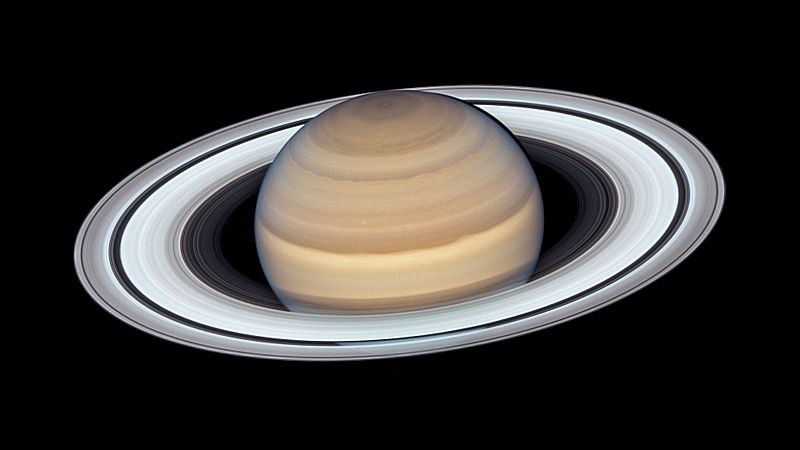Image: Saturn - HST 2019-06-20 full size

Description: Uploader's notes: the original ESA / NASA 2505 x 1592 pixel TIFF image has been modified by cropping and conversion to JPEG format. Original caption released with image: Anyone who has ever peered at Saturn through a small telescope is immediately enticed by its elegant rings, which make the far-flung planet one of the most exotic-looking, opulent worlds in the solar system. The latest view of Saturn from NASA's Hubble Space Telescope captures exquisite details of the ring system—which looks like a phonograph record with grooves that represent detailed structure within the rings—and atmospheric details that once could only be captured by spacecraft visiting the distant world. One such intriguing feature is the long-lasting hexagon-shaped structure circling the planet's north pole. It is a mysterious six-sided pattern caused by a high-speed jet stream. NASA's Voyager 1 spacecraft first discovered the "hexagon" during its flyby in 1981. The hexagon is so large that four Earths could fit inside its boundaries. (There is no similar structure at Saturn's south pole.) Other features, however, are not as long lasting. A large storm in the north polar region spotted by Hubble last year has disappeared. Smaller, convective storms—called super "thunderheads"—such as the one just above the center of the planet's image, also come and go. Saturn's appearance changes with its seasons, which occur because Saturn's equator is tilted 27 degrees with respect to the plane of its orbit around the Sun. The Earth, similarly, has seasons because our planet is tilted by about 23.5 degrees, but seasons on Saturn last more than seven years. This new Saturn image was taken during summer in the planet's northern hemisphere. The amber colors of the planet in this image come from summer smog-like hazes, produced in photochemical reactions driven by solar ultraviolet radiation. Below the haze lie clouds of ammonia ice crystals, as well as deeper, unseen lower-level clouds of ammonium hydrosulfide and water. Saturn's banded structure is caused by alternating winds that result in clouds at different altitudes at each latitude. Saturn's trademark ring system is now tilted toward Earth, giving viewers a magnificent look at its bright, icy structure. The high resolution of Hubble's Wide Field Camera 3 allows us to see numerous ringlets and the fainter inner rings. The planet teased and tantalized Galileo Galilei in 1610, who was astonished when he first saw its rings through the newly invented telescope. However, Galileo mistook them for weird appendages stuck to the planet, because his handheld telescope wasn’t very powerful. Dutch astronomer Christiaan Huygens first identified the rings as a separate phenomenon in 1655, but still he thought they were a continuous disk encircling the planet. Today, we know the rings are mostly made of pieces of ice, with sizes ranging from tiny grains to giant boulders. And they are constantly moving around the planet in an intricate cosmic dance. The age of Saturn's ring system continues to be debated. And, even more perplexing, no one knows what cosmic catastrophe formed the rings. Additional clues came as NASA's Cassini spacecraft plunged into Saturn's atmosphere on Sept. 15, 2017. NASA ended the mission in this way to prevent the spacecraft from accidentally crashing into one of Saturn's moons, but Cassini's dramatic finish also provided valuable scientific insights. During its final orbits, Cassini measured the mass of the ring system as merely 1/1000th the mass of Earth's Moon. Some astronomers have interpreted this low mass to mean that the rings may only be 100 million years old, a fraction of Saturn's age. However, there is still no consensus among planetary astronomers today. Hubble's Wide Field Camera 3 observed Saturn on June 20, 2019, as the planet made its closest approach to Earth, at about 845 million miles away. This image is the second in a yearly series of snapshots taken as part of the Outer Planets Atmospheres Legacy (OPAL) project. OPAL is helping scientists understand the atmospheric dynamics and evolution of our solar system's gas giant planets. In Saturn's case, astronomers will be able to track shifting weather patterns and other changes to identify trends.
Title: Saturn - HST 2019-06-20 full size
Credit: https://www.spacetelescope.org/images/heic1917a/ For caption, see: https://hubblesite.org/contents/media/images/2019/43/4565-Image
Author: NASA, ESA, A. Simon (Goddard Space Flight Center), M.H. Wong (UC Berkeley), OPAL Team
Usage Terms: Public domain
License: Public domain
Attribution Required?: No
Image usage
The following page links to this image:

